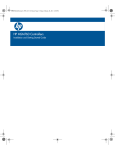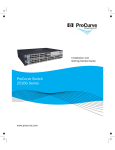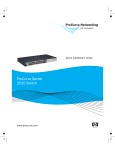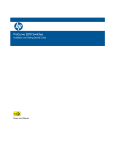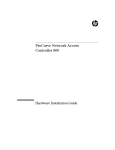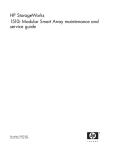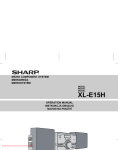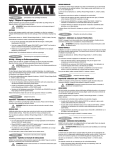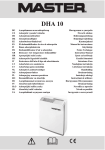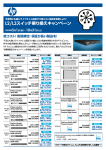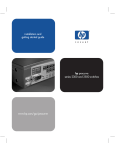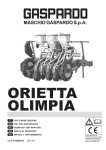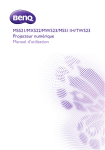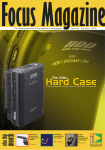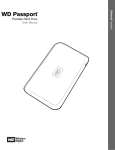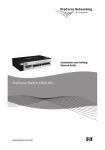Download J4097C - ftp
Transcript
Installation Guide ProCurve Switch 408 www.procurve.com ProCurve Switch 408 Installation Guide © Copyright 2001, 2005, 2006, 2007 HewlettPackard Development Company L.P. The information contained herein is subject to change without notice. This document contains proprietary information, which is protected by copyright. No part of this document may be photocopied, reproduced, or translated into another language without prior written consent of Hewlett-Packard. Publication Number 5991-6250 February 2007 Applicable Product ProCurve Switch 408 (J4097C) Safety Before installing and operating this product, please read the “Installation Precautions” in chapter 2, “Installing the Switch 408”, and the safety statements in appendix C, “Safety and EMC Regulatory Statements”. Disclaimer HEWLETT-PACKARD COMPANY MAKES NO WARRANTY OF ANY KIND WITH REGARD TO THIS MATERIAL, INCLUDING, BUT NOT LIMITED TO, THE IMPLIED WARRANTIES OF MERCHANTABILITY AND FITNESS FOR A PARTICULAR PURPOSE. HewlettPackard shall not be liable for errors contained herein or for incidental or consequential damages in connection with the furnishing, performance, or use of this material. The only warranties for HP products and services are set forth in the express warranty statements accompanying such products and services. Nothing herein should be construed as constituting an additional warranty. HP shall not be liable for technical or editorial errors or omissions contained herein. Hewlett-Packard assumes no responsibility for the use or reliability of its software on equipment that is not furnished by Hewlett-Packard. Warranty See the Customer Support/Warranty booklet included with the product. A copy of the specific warranty terms applicable to your Hewlett-Packard products and replacement parts can be obtained from your HP Sales and Service Office or authorized dealer. Hewlett-Packard Company 8000 Foothills Boulevard, m/s 5552 Roseville, California 95747-5552 www.procurve.com Contents 1 Introducing the Switch 408 Front of the Switch . . . . . . . . . . . . . . . . . . . . . . . . . . . . . . . . . 1-2 Network Ports . . . . . . . . . . . . . . . . . . . . . . . . . . . . . . . . . . . . 1-2 LEDs . . . . . . . . . . . . . . . . . . . . . . . . . . . . . . . . . . . . . . . . . . . . 1-3 Back of the Switch . . . . . . . . . . . . . . . . . . . . . . . . . . . . . . . . . . 1-4 Power Connector . . . . . . . . . . . . . . . . . . . . . . . . . . . . . . . . . 1-4 Features . . . . . . . . . . . . . . . . . . . . . . . . . . . . . . . . . . . . . . . . . . . . 1-5 Switch Operation Overview . . . . . . . . . . . . . . . . . . . . . . . . . . 1-5 Address Table Operation . . . . . . . . . . . . . . . . . . . . . . . . . . . 1-5 2 Installing the Switch 408 Included Parts . . . . . . . . . . . . . . . . . . . . . . . . . . . . . . . . . . . . . . 2-1 Japan Power Cord Warning . . . . . . . . . . . . . . . . . . . . . . . . . 2-2 Installation Procedures . . . . . . . . . . . . . . . . . . . . . . . . . . . . . 2-2 Summary . . . . . . . . . . . . . . . . . . . . . . . . . . . . . . . . . . . . . . . . 2-2 Installation Precautions . . . . . . . . . . . . . . . . . . . . . . . . . . . . 2-3 1. Prepare the Installation Site . . . . . . . . . . . . . . . . . . . . . . 2-5 2. Verify the Switch Passes Its Self Test . . . . . . . . . . . . . . 2-6 3. Mount the Switch . . . . . . . . . . . . . . . . . . . . . . . . . . . . . . . 2-8 4. Connect the Switch to a Power Source . . . . . . . . . . . . . 2-9 5. Connect the Network Cables . . . . . . . . . . . . . . . . . . . . . 2-9 Sample Network Topologies . . . . . . . . . . . . . . . . . . . . . . . . 2-10 As a Desktop Switch . . . . . . . . . . . . . . . . . . . . . . . . . . . . . . 2-10 As a Segment Switch . . . . . . . . . . . . . . . . . . . . . . . . . . . . . 2-11 iii 3 Troubleshooting Basic Troubleshooting Tips . . . . . . . . . . . . . . . . . . . . . . . . . 3-1 Diagnosing With the LEDs . . . . . . . . . . . . . . . . . . . . . . . . . . 3-3 Hardware Diagnostic Tests . . . . . . . . . . . . . . . . . . . . . . . . . 3-5 Testing the Switch by Resetting It . . . . . . . . . . . . . . . . . . 3-5 Testing Twisted-Pair Cabling . . . . . . . . . . . . . . . . . . . . . . . 3-5 Testing End-to-End Network Communications . . . . . . . 3-6 ProCurve Customer Support Services . . . . . . . . . . . . . . . 3-6 A Specifications Physical . . . . . . . . . . . . . . . . . . . . . . . . . . . . . . . . . . . . . . . . . A-1 Electrical . . . . . . . . . . . . . . . . . . . . . . . . . . . . . . . . . . . . . . . A-1 Environmental . . . . . . . . . . . . . . . . . . . . . . . . . . . . . . . . . . A-1 Connectors . . . . . . . . . . . . . . . . . . . . . . . . . . . . . . . . . . . . . . A-2 Safety . . . . . . . . . . . . . . . . . . . . . . . . . . . . . . . . . . . . . . . . . . A-2 B Cables and Connectors Twisted-Pair Cable/Connector Pin-Outs . . . . . . . . . . . . . . . . . . . . . . . . . . . . . . . . . . . . . . . . . . . B-1 Straight-Through Twisted-Pair Cable . . . . . . . . . . . . . . . . B-2 Crossover Twisted-Pair Cable . . . . . . . . . . . . . . . . . . . . . . B-3 Twisted-Pair Cable Pin Assignments . . . . . . . . . . . . . . . . B-4 C Safety and Regulatory Statements Safety Information . . . . . . . . . . . . . . . . . . . . . . . . . . . . . . . . . C-1 Informations concernant la sécurité . . . . . . . . . . . . . . . . . C-3 iv Hinweise zur Sicherheit . . . . . . . . . . . . . . . . . . . . . . . . . . . . C-4 Considerazioni sulla sicurezza . . . . . . . . . . . . . . . . . . . . . . C-5 Consideraciones sobre seguridad . . . . . . . . . . . . . . . . . . . C-6 Safety Information (Japan) . . . . . . . . . . . . . . . . . . . . . . . . C-7 Safety Information (China) . . . . . . . . . . . . . . . . . . . . . . . . C-8 EMC Regulatory Statements . . . . . . . . . . . . . . . . . . . . . . . C-9 U.S.A. . . . . . . . . . . . . . . . . . . . . . . . . . . . . . . . . . . . . . . . . . . C-9 Canada . . . . . . . . . . . . . . . . . . . . . . . . . . . . . . . . . . . . . . . . . C-9 Australia/New Zealand . . . . . . . . . . . . . . . . . . . . . . . . . . . . C-9 Japan . . . . . . . . . . . . . . . . . . . . . . . . . . . . . . . . . . . . . . . . . C-10 Korea C-10 Taiwan C-10 European Community . . . . . . . . . . . . . . . . . . . . . . . . . . . C-11 Regulatory Information (China) . . . . . . . . . . . . . . . . . . . C-12 D Recycle Statements Waste Electrical and Electronic Equipment (WEEE) Statements . . . . . . . . . . . . . . . . . . . . . . . . . . . . . . . . . . . . . . . . D-1 v —This page is intentionally unused— 1 Introducing the Switch 408 The ProCurve Switch 408 is a multiport switch that can be used to build high-performance switched workgroup networks. This switch is a store-and-forward device that offers low latency for high-speed networking. ProCurve Switch 408 (J4097C) C Throughout this manual, the name of this switch will be abbreviated as the Switch 408. The Switch 408 has eight auto-sensing 10/100Base-TX RJ-45 ports. With this switch you can build a switched network infrastructure by connecting it to hubs, other switches, or routers; or you can connect directly to computers, printers, and servers to provide dedicated bandwidth to those devices. This chapter describes your Switch 408 including: ■ Front and back of the switch ■ Features ■ Switch operation overview 1-1 Introducing the Switch 408 Front of the Switch Front of the Switch Power LED 10/100Base-TX RJ-45 ports (all ports have the HP Auto-MDIX feature) C Fault LED Link/Act, FDx, and 100 LEDs for each port Network Ports The switch has eight auto-sensing 10/100Base-TX ports with RJ-45 connectors. All of the ports have the HP Auto- MDIX feature, which means that either a straight-through or cross-over cable can be used for any connection to another device, and the switch automatically adjusts the pin assignments to complete the connection. 1-2 Introducing the Switch 408 Front of the Switch LEDs Table 1-1. Switch LEDs Switch LEDs State Meaning Pwr (green) On The switch is receiving power. Off The switch is NOT receiving power. Fault (orange) Off The normal state; indicates that there are no fault conditions on the switch. On The switch has a hardware failure, or has failed its self test. See chapter 3, “Troubleshooting” for more information. On Indicates the port is operating correctly and receiving a link signal from the connected device. Off One of these conditions exists: • no active network cable is connected to the port • the port is not receiving a link signal Flickering Indicates that there is network activity on the port. FDx (green) On The corresponding port is operating at full duplex Off The corresponding port is operating at half duplex 100 (green) On The corresponding port is operating at 100 Mbps. Off The corresponding port is operating at 10 Mbps. Link/Act (green – overlaid with the port number) 1-3 Introducing the Switch 408 Back of the Switch Back of the Switch . 12 - 13V 1.0 - 0.8A power connector Power Connector The Switch 408 does not have a power switch; it is powered on when the AC power adapter is plugged in to an active power source and to the switch. Caution 1-4 Use only the AC power adapter supplied with the switch. Use of other adapters, including adapters that came with other HP network products, may result in damage to the equipment. Introducing the Switch 408 Features Features The features of the Switch 408 include: ■ eight auto-sensing 10/100Base-TX RJ-45 ports—all ports can sense the connection speed, 10 Mbps or 100 Mbps, and automatically operate at that speed ■ HP Auto-MDIX on all ports—all ports allow you to use either a straight-through or crossover cable to connect to any other RJ-45 network device. There are no switches or buttons to deal with, and no more worrying about what type of cable is needed to connect to an end node, or to another switch or hub. ■ plug-and-play networking—all ports are enabled—just connect the network cables to active network devices and your switched network is operational ■ automatic learning of the hardware addresses in the switch’s 1000-entry address forwarding table ■ auto-negotiation of half/full duplex on all ports ■ auto-negotiation of flow control for ports operating at full duplex Switch Operation Overview Address Table Operation Address Learning. As devices are connected to the switch ports, either directly or through hubs or other switches that are connected to the switch, the MAC addresses of those devices are learned auto- 1-5 Introducing the Switch 408 Switch Operation Overview matically and stored in the Switch 408’s 1000-entry address table. The switch also identifies the number of the port on which each address is learned so it knows the relative network location of each device. Forwarding, Filtering, Flooding. When the switch receives a packet, it determines the destination address, and looks for the address in the address table. Based on the port location of that address, the switch then determines whether to forward, filter-out, or flood the packet. ■ forward - if the destination address is on a different port than the one on which the packet was received, the packet is forwarded to the destination port and on to the destination device. ■ filter out - if the destination address is on the same port as the one on which the packet was received, the packet is filtered out. The switch thereby isolates local traffic so the rest of the network connected to the switch does not use bandwidth dealing with unnecessary traffic. ■ flood - whenever a new destination address is found in a packet received on a port, the destination address will not yet be in the switch’s address table and the Switch 408 cannot know whether to forward or filter out the packet. In this case, it sends the packet to all the other switch ports. This is referred to as “flooding”. When the destination device receives the packet, it replies, and the switch learns the new address from the reply packet. Then, all future packets destined for that address are forwarded or filtered out appropriately. Network Moves and Changes. When devices are moved in the network, and become connected to a different switch port, the Switch 408 automatically recognizes the change and updates the address table with the new port locations of the devices. Communication with the connected devices is thereby automatically maintained. 1-6 2 Installing the Switch 408 The ProCurve Switch 408 is easy to install. It comes with four rubber feet that can be attached so the switch can be securely located on any level surface (for example, a table or shelf). A mounting kit (51837210) is also available that provides a variety of mounting options including in a standard 19-inch EIA equipment rack or cabinet, on a wall, or under a horizontal surface. Contact your HP Networking products reseller to order the mounting kit. This chapter shows you how to install your Switch 408. Included Parts The Switch 408 has the following components shipped with it: ■ ProCurve Switch 408 Installation Guide (5991-6250), this manual ■ Customer Support/Warranty booklet ■ Four rubber feet ■ AC power adapter, one of the following: Australia/New Zealand China Denmark/Switzerland Europe/Russia Japan United Kingdom/Hong Kong/Singapore United States/Canada/Taiwan 5188-5678 5188-5677 5188-5673 5188-5673 5188-5676 5188-5672 5188-5671 2-1 Installing the Switch 408 Installation Procedures Japan Power Cord Warning Installation Procedures Summary Follow these easy steps to install your switch. The rest of this chapter provides details on these steps. 1. Prepare the installation site. Make sure of the following: • the network cabling is the correct type and length. See page 2-5. • the network topology is correct. See page 2-10. • no devices connected to the switch have a fixed full-duplex configuration (they must be able to auto-negotiate the duplex mode or be fixed at half duplex). See page 2-4. See page 2-3 for installation precautions. 2. Verify that the switch passes its self test. This is a simple process of plugging the switch into a power source and observing that the LEDs on the switch’s front panel show correct operation. See page 2-7. 3. Mount the switch. The Switch 408 can be mounted on any horizontal surface. The optional mounting kit (5183-7210) provides other options including mounting two switch units sideby-side in a standard 19-inch telco rack or equipment cabinet. 4. Connect power to the switch. Once the switch is mounted, plug in the AC power adapter. See page 2-9. 2-2 Installing the Switch 408 Installation Procedures 5. Connect the network devices. Using the appropriate network cables, connect computers, servers, printers and other peripherals, and other network devices including other switches, hubs, or routers to the switch ports. See page 2-9. At this point, the switch is fully installed and your network should be up and running. See the rest of this chapter if you need more detailed information on any of these installation steps. Installation Precautions Follow these precautions when installing your Switch 408: Cautions ■ Make sure you use the power adapter supplied with the switch to connect it to an AC power source. ■ When installing the switch, since the unit does not have an On/Off power switch, an AC power outlet must be located near the switch and should be easily accessible in case the switch needs to be powered off. ■ Make sure the switch does not overload the power circuits, wiring, and over-current protection. To determine the possibility of overloading the supply circuits, add together the amperage ratings of all devices installed on the same circuit as the switch and compare the total with the rating limit for the circuit. The maximum amperage ratings are usually printed on the devices near the AC power connectors or power adapter connectors. ■ Do not install the switch in an environment where the operating ambient temperature might exceed 40°C (104°F). ■ Make sure the air flow around the sides of the switch is not restricted. Continued on the next page. 2-3 Installing the Switch 408 Installation Procedures 2-4 ■ If you rack mount the Switch 408 (using the mounting kit, 5183-7210), the rack or cabinet should be adequately secured to prevent it from becoming unstable and/or falling over. Devices installed in a rack or cabinet should be mounted as low as possible, with the heaviest device at the bottom and progressively lighter devices installed above. ■ Connect no devices that have a fixed full-duplex configuration. Because the switch 408 complies with the IEEE 802.3u standard, if a device connected to the switch has a fixed configuration of full duplex, the device will not connect correctly to the switch. Make sure all devices connected to the Switch 408 are configured to auto negotiate, or are configured to connect at half duplex. For more information, see the “Basic Troubleshooting Tips” in chapter 3, “Troubleshooting”. Installing the Switch 408 Installation Procedures 1. Prepare the Installation Site ■ Cabling Infrastructure - Make sure the cabling infrastructure meets the necessary network specifications. Because of the HP Auto-MDIX feature, for connections to end nodes (computers, servers, printers and other peripherals), or connections to hubs or other switches, you can use straight-through cables. Crossover cables can also be used for any of these connections. See the following table for cable types and lengths, and see appendix B, “Cables and Connectors” for more information: Table 2-1. ■ Summary of Cable Types to Use with the Switch Port Type Cable Type Length Limits 10Base-T category 3, 4, or 5, 100-ohm unshielded twisted-pair (UTP) or shielded twisted-pair (STP) category 3, 4, or 5 - 100 meters Note: Since the 10Base-T operation is through 10/100Base-TX ports, if you ever want to upgrade the ports to 100Base-T, it would be best to cable the ports initially with category 5 cable. 100Base-TX category 5, 100-ohm UTP or STP 100 meters Installation Location - Before installing the switch, plan its location and orientation relative to other devices and equipment. At the front of the switch, leave at least 7.6 cm (3 inches) of space for the twisted-pair cabling. At the back of the switch, leave at least 2.6 cm (1 inch) of space for the adapter’s power cord. 2-5 Installing the Switch 408 Installation Procedures 2. Verify the Switch Passes Its Self Test Before mounting the switch in its network location, you should first check that it is working properly by plugging it into a power source and verifying that it passes its self test. 1. Connect the adapter’s power cord to the power connector on the back of the switch, and then plug the AC power adapter into a nearby properly grounded electrical outlet. 12 - 13V 1.0 - 0.8A Connect power cord to the power connector Note The Switch 408 does not have a power switch. It is powered on when the AC power adapter is connected to the switch and to a power source. Caution Use only the AC power adapter supplied with the switch. Use of other adapters, including those that came with other HP network products, may result in damage to the equipment. 2. 2-6 Check the LEDs on the switch. The LED behavior is described on the next page. Installing the Switch 408 Installation Procedures Switch port LEDs C Power and Fault LEDs When the switch is powered on, it performs its diagnostic self test. The self test takes approximately 3 seconds to complete. LED Behavior: During the self test: • All the switch and port LEDs are on. When the self test completes successfully: • The Power LED stays on and the Fault LED goes off. • The port LEDs (Link/Act, FDx, and 100) go into their normal operational mode. If the LED display is different than what is described above, especially if the Fault LED stays on for more than 5 seconds, the self test has not completed correctly. Refer to chapter 3, “Troubleshooting” for diagnostic help. 2-7 Installing the Switch 408 Installation Procedures 3. Mount the Switch After you have verified that the switch passes its self test, you are ready to mount the switch in a stable location. The Switch 408 can be mounted in these ways: ■ on a horizontal surface ■ in a rack or cabinet, or on a wall (requires optional bracket kit) Horizontal Surface Mounting Attach the supplied rubber feet to the bottom of the switch, then place the switch on a table or other horizontal surface. Use a sturdy surface in an uncluttered area. You may want to secure the networking cables and switch power cord to the table legs or other part of the surface structure to help prevent people from tripping over the cords. Note Make sure the air flow is not restricted around the sides of the switch. Rack or Wall Mounting Using the optional bracket kit (5183-7210), two Switch 408 units can be mounted together in any EIA-standard 19-inch telco rack or in an equipment cabinet such as a server cabinet. The switch brackets can also be used to mount the switch on a wall or under a horizontal surface. Installation instructions are included with the bracket kit. Caution 2-8 For safe operation, please read the Installation Precautions on page 2-3 before mounting the switch. Installing the Switch 408 Installation Procedures 4. Connect the Switch to a Power Source 1. Plug the included AC power adapter into the switch’s power connector and into a nearby AC power source. 2. Re-check the LEDs during self test. See “LED Behavior” on page 2-7. 5. Connect the Network Cables Using the RJ-45 Connectors (10/100Base-TX ports) To connect: Push the RJ-45 plug into the RJ-45 jack until the tab on the plug clicks into place. When power is on for the switch and for the connected device, the Link/Act LED for the port should light to confirm a powered-on device (for example, an end node) is at the other end of the cable. If the Link LED does not go on when the network cable is connected to the port, see “Diagnosing With the LEDs” in chapter 3, “Troubleshooting”. RJ-45 connector 100-ohm unshielded or shielded twisted-pair cable: • Category 3, 4, or 5 for 10 Mbps ports • Category 5 only for 100 Mbps ports Maximum distance: 100 meters To disconnect: Press the small tab on the plug and pull the plug out of the jack. 2-9 Installing the Switch 408 Sample Network Topologies Sample Network Topologies This section shows you two sample network topologies in which the Switch 408 is implemented. Note Make sure the network into which you are installing the Switch 408 has a valid topology: there should be no loops in the data paths connected to the switch, and all twistedpair connections should be no more than 100 meters. As a Desktop Switch Server twisted-pair straight-through or crossover cables Switch 408 PCs and peripherals The Switch 408 is designed to be used primarily as a desktop switch to which end nodes, printers and other peripherals, and servers are directly connected, as shown in the above illustration. 2-10 Installing the Switch 408 Sample Network Topologies As a Segment Switch Server 100 Mbps connection through category 5 twisted-pair cable 100Base-TX connection to a backbone switch Switch 408 twisted-pair cables twisted-pair cables Ethernet Hubs PCs, printers, and local servers In general, the Switch 408 is designed to be used as a desktop switch, but it can also be used as a segment switch. That is, it can be used for interconnecting network segments—simply connect the network hubs that form those segments to the switch. In the illustration above, two Ethernet hubs with PCs, printers, and local servers attached, are both connected to a Switch 408. The devices attached to the two hubs can now communicate with each other through the switch. They can also all communicate with the server that is connected to the switch. Make sure connections from servers to the Switch 408 are at 100 Mbps to minimize network congestion to the servers. 2-11 Installing the Switch 408 Sample Network Topologies Note that because of the HP Auto-MDIX feature, all twisted-pair connections between the switch and the MDI-X ports or MDI ports on hubs, and the connections to the end nodes and the servers can be through “straight-through” cables. You can also use “crossover” cables for these connections. In either case, the Switch 408 automatically adjusts to the type of cable used and to the type of device at the other end of the connection. The 100 Mbps connection to the server and any other 100 Mbps connections must be through category 5 or better cable. 2-12 3 Troubleshooting This chapter describes how to troubleshoot your Switch 408 including the following: ■ basic troubleshooting tips (page 3-1) ■ diagnosing with the LEDs (page 3-3) ■ hardware diagnostic tests (page 3-5) ■ ProCurve Customer Support Services (page 3-6) Basic Troubleshooting Tips Most problems are caused by the following situations: ■ Connecting to devices with a fixed full-duplex configuration. The Switch 408 ports are set to auto-negotiate the link characteristics. That is, when connecting to attached devices, the switch will operate in one of two ways to determine the link speed and the communication mode (half duplex or full duplex): • if the connected device is also set to auto negotiate, the switch will automatically negotiate both link speed and communication mode • if the connected device has a fixed configuration, for example (100 Mbps, and half or full duplex), the switch will automatically sense the link speed, but will default to a communication mode of half duplex 3-1 Troubleshooting Basic Troubleshooting Tips Because the Switch 408 behaves in this way (in compliance with the IEEE 802.3u standard), if a device connected to the switch has a fixed configuration at full duplex, the device will not connect correctly to the Switch 408. The result will be high error rates and high collision rates, and very inefficient communications between the switch and the device. Make sure that all devices connected to the Switch 408 are configured to auto negotiate, or are configured to connect at half duplex (all hubs are configured this way, for example). ■ Faulty or loose cables. Look for loose or obviously faulty connections. If they appear to be OK, make sure the connections are secure. If that does not correct the problem, try a different cable. ■ Non-standard cables. Non-standard and miswired cables may cause numerous network collisions and other network problems, and can seriously impair network performance. Use a new correctly-wired cable or compare your cable to the cable in appendix B, “Cables and Connectors” for pinouts and correct cable wiring. A category 5 cable tester is a recommended tool for every 100Base-T network installation. ■ Improper Network Topologies. It is important to make sure you have a valid network topology. Common topology faults include excessive cable length and too many repeaters (hubs) between end nodes. If you have network problems after recent changes to the network, change back to the previous topology. If you no longer experience the problems, the new topology is probably at fault. Refer to the Network Design Guide for topology configuration guidelines. This guide can be found online at the ProCurve Networking web site, http://www.procurve.com. You can find it quickly by searching for “Network Design Guide”. 3-2 Troubleshooting Diagnosing With the LEDs In addition, you should make sure that your network topology contains no data path loops. Between any two end nodes, there should be only one active cabling path at any time. Data path loops will cause broadcast storms that will severely impact your network performance. Diagnosing With the LEDs Table 3-1 shows LED patterns on the switch that indicate problem conditions. 1. Check in the table for the LED pattern that you see on your switch. 2. Refer to the corresponding diagnostic tip on the next few pages. Table 3-1. LED Error Indicators LED Pattern Indicating Problems Power Fault Port Link Diagnostic Tips Off with power cord plugged in * * ➊ On Prolonged On * ➋ On Off Off with cable connected ➌ * This LED is not important for the diagnosis. 3-3 Troubleshooting Diagnosing With the LEDs Diagnostic Tips: Tip Number 3-4 Problem Solution ➊ The switch’s power adapter is not plugged into an active AC power source, or the power adapter may have failed. 1. Verify the AC power adapter is plugged into an active power source and to the switch. Make sure these connections are snug. 2. Try power cycling the switch by unplugging and plugging in the power. 3. If the Power LED is still not on, verify that the AC power source works by plugging another device into the outlet. Or try plugging the switch into a different outlet. If this condition persists, the switch’s power adapter may have failed. Call your ProCurve authorized LAN dealer, or use the electronic support services from ProCurve to get assistance. See the Customer Support/Warranty booklet for more information. ➋ A switch hardware failure was detected during self test. Try power cycling the switch. If the fault indication reoccurs, the switch may have failed. Call your ProCurve authorized LAN dealer, or use the electronic support services from ProCurve to get assistance. See the Customer Support/ Warranty card for more information. ➌ The network connection is not working properly. Try the following procedures: • For the indicated port, verify that both ends of the cabling, at the switch and the connected device, are secure. • Verify the connected device and switch are both powered on and operating correctly. • Verify that the connected devices comply with the appropriate IEEE 802.3 standard, including transmission of the Link signal. See “Testing Twisted-Pair Cabling” on page 3-5. • If the other procedures don’t resolve the problem, try using a different port or a different cable. Troubleshooting Hardware Diagnostic Tests Hardware Diagnostic Tests Testing the Switch by Resetting It If you believe that the switch is not operating correctly, you can reset the switch to test its circuitry. To reset the switch, unplug and plug in the adapter’s power cord (power cycling). Power cycling causes the switch to perform its power-on self-test, and almost always will resolve any temporary operational problems. Checking the Switch LEDs The self-test passes if the Fault LED on the front of the switch goes off after approximately 3 seconds. If this LED stays on longer than 5 seconds, an error condition has been detected on the switch. See “Diagnosing With the LEDs” on page 3-3 for information on interpreting the LED patterns. Testing Twisted-Pair Cabling If you think the cable should work but still isn’t working, it may not be compatible with the IEEE 802.3 Type 10Base-T or 100Base-TX standards. The twisted-pair cables attached to the Switch 408 must be compatible with these standards. To verify that your cable is compatible with these standards, use a qualified cable test device. ProCurve also offers a wire testing service. Contact your ProCurve authorized LAN dealer or your local ProCurve sales office for more information. 3-5 Troubleshooting ProCurve Customer Support Services Testing End-to-End Network Communications Both the switch and the cabling can be tested by running an end-toend communications test -- a test that sends known data from one network device to another through the switch. For example, if you have two PCs on the network, both connected to the switch, you can use a link-level packet test (link test) or Ping test to verify that the entire communication path between the two PCs is functioning correctly. See your LAN adapter documentation for more information on running a link test or Ping test. ProCurve Customer Support Services If you are still having trouble with your switch, ProCurve offers support 24 hours a day, seven days a week through the use of a number of automated electronic services. See the Customer Support/ Warranty booklet that came with your switch for information on how to use these services to get technical support. The ProCurve Networking Web site, http://www.procurve.com also provides up-todate support information. Additionally, your ProCurve authorized network reseller can provide you with assistance, both with services that they offer and with services offered by ProCurve. 3-6 A Specifications Physical Width: 19.9 cm (7.8 in) Depth: 12.1 cm (4.8 in) Height: 4.0 cm (1.6 in) Weight : 0.72 kg (1.60 lbs) Electrical DC voltage: 12–13 volts Maximum current: 1.0–0.8 A Environmental Operating Non-Operating Temperature: 0°C to 40°C (32°F to 104°F) -40°C to 70°C (-40°F to 158°F) Relative humidity: (non-condensing) 10% to 90% at 40°C (104°F) 10% to 90% at 65°C (149°F) Maximum altitude: 3.0 km (9,843 ft) 4.6 km (15,000 ft) A-1 Specifications Connectors ■ The 10/100 Mbps RJ-45 twisted-pair ports are compatible with the IEEE 802.3u 100Base-TX and IEEE 802.3 Type 10Base-T standards. All ports include the HP Auto-MDIX feature, which allows the use of either straight-through or crossover cables for any twisted-pair connection. Safety The Switch 408 complies with these safety standards: ■ EN60950 / IEC 60950 ■ CSA/NRTL (CSA 22.2 No. 60950 & UL 60950) A-2 B Cables and Connectors This appendix includes minimum pin-out information and specifications for cables that should be used with the Switch 408. Note Incorrectly wired cabling is the most common cause of problems for LAN communications. ProCurve recommends that you work with a qualified LAN cable installer for assistance with your cabling requirements. Twisted-Pair Cable/Connector Pin-Outs The RJ-45 ports (10 Mbps and 100 Mbps) on the Switch 408 have the HP Auto-MDIX feature, which allows you to use either straightthrough or crossover twisted-pair cables for connections to any other network device that has RJ-45 connectors. These additional rules apply to the twisted-pair cabling: ■ All twisted-pair wires used must be twisted through the entire length of the cable. The wiring sequence must conform to the ANSI/TIA/EIA-568-B cable specification. See “Twisted-Pair Cable Pin Assignments” later in this appendix for a listing of the signals used on each pin. B-1 Cables and Connectors Twisted-Pair Cable/Connector Pin-Outs ■ For 10 Mbps connections to the ports, you can use 100-ohm Category 3, 4, or 5 unshielded (UTP) or shielded (STP) twistedpair cable, as supported by the IEEE 802.3 Type 10Base-T standard. ■ For 100 Mbps connections to the ports, use 100-ohm Category 5 UTP or STP cable only, as supported by the IEEE 802.3u Type 100Base-TX standard. Straight-Through Twisted-Pair Cable Connector “A” Connector “B” Straight-Through Cable white/orange orange/white white/green green/white Note Pins 1 and 2 on connector “A” must be wired as a twisted pair to pins 1 and 2 on connector “B”. Pins 3 and 6 on connector “A” must be wired as a twisted pair to pins 3 and 6 on connector “B”. Pins 4, 5, 7, and 8 are not used in this application, although they may be wired in the cable. B-2 Cables and Connectors Twisted-Pair Cable/Connector Pin-Outs Crossover Twisted-Pair Cable Connector “A” Connector “B” Crossover Cable white/orange orange/white white/green green/white Note Pins 1 and 2 on connector “A” must be wired as a twisted pair to pins 3 and 6 on connector “B”. Pins 3 and 6 on connector “A” must be wired as a twisted pair to pins 1 and 2 on connector “B”. Pins 4, 5, 7, and 8 are not used in this application, although they may be wired in the cable. B-3 Cables and Connectors Twisted-Pair Cable/Connector Pin-Outs Twisted-Pair Cable Pin Assignments Twisted-Pair Straight-Through Cable Switch End Computer, Transceiver, or Other MDI Port End Signal Pins Pins Signal receive + receive transmit + transmit - 1 2 3 6 1 2 3 6 transmit + transmit receive + receive - Twisted-Pair Crossover Cable Switch End Hub or Switch Port, or Other MDI-X Port End Signal Pins Pins Signal receive + receive transmit + transmit - 1 2 3 6 6 3 2 1 transmit transmit + receive receive + B-4 C Safety and Regulatory Statements Safety Information ! Documentation reference symbol. If the product is marked with this symbol, refer to the product documentation to get more information about the product. WARNING A WARNING in the manual denotes a hazard that can cause injury or death. CAUTION A CAUTION in the manual denotes a hazard that can damage equipment. Do not proceed beyond a WARNING or CAUTION notice until you have understood the hazardous conditions and have taken appropriate steps. Grounding These are safety class I products and have protective earthing terminals. There must be an uninterruptible safety earth ground from the main power source to the product’s input wiring terminals, power cord, or supplied power cord set. Whenever it is likely that the protection has been impaired, disconnect the power cord until the ground has been restored. For LAN cable grounding: ■ If your LAN covers an area served by more than one power distribution system, be sure their safety grounds are securely interconnected. C-1 Safety and Regulatory Statements Safety Information ■ LAN cables may occasionally be subject to hazardous transient voltages (such as lightning or disturbances in the electrical utilities power grid). Handle exposed metal components of the network with caution. Servicing There are no user-serviceable parts inside these products. Any servicing, adjustment, maintenance, or repair must be performed only by service-trained personnel. These products do not have a power switch; they are powered on when the adapter’s power cord is plugged in. C-2 Safety and Regulatory Statements Informations concernant la sécurité Informations concernant la sécurité ! Symbole de référence à la documentation. Si le produit est marqué de ce symbole, reportez-vous à la documentation du produit afin d'obtenir des informations plus détaillées. WARNING Dans la documentation, un WARNING indique un danger susceptible d'entraîner des dommages corporels ou la mort. CAUTION Un texte de mise en garde intitulé CAUTION indique un danger susceptible de causer des dommages à l'équipement. Ne continuez pas au-delà d'une rubrique WARNING ou CAUTION avant d'avoir bien compris les conditions présentant un danger et pris les mesures appropriées. Cet appareil est un produit de classe I et possède une borne de mise à la terre. La source d'alimentation principale doit être munie d'une prise de terre de sécurité installée aux bornes du câblage d'entrée, sur le cordon d'alimentation ou le cordon de raccordement fourni avec le produit. Lorsque cette protection semble avoir été endommagée, débrancher le cordon d'alimentation jusqu'à ce que la mise à la terre ait été réparée. Mise à la terre du câble de réseau local: ■ si votre réseau local s'étend sur une zone desservie par plus d'un système de distribution de puissance, assurez-vous que les prises de terre de sécurité soient convenablement interconnectées. ■ Les câbles de réseaux locaux peuvent occasionnellement être soumis à des surtensions transitoires dangereuses (telles que la foudre ou des perturbations dans le réseau d'alimentation public). Manipulez les composants métalliques du réseau avec précautions. Aucune pièce contenue à l'intérieur de ce produit ne peut être réparée par l'utilisateur. Tout dépannage, réglage, entretien ou réparation devra être confié exclusivement à un personnel qualifié. Cet appareil ne comporte pas de commutateur principal ; la mise sous tension est effectuée par branchement du cordon d'alimentation. C-3 Safety and Regulatory Statements Hinweise zur Sicherheit Hinweise zur Sicherheit ! Symbol für Dokumentationsverweis. Wenn das Produkt mit diesem Symbol markiert ist, schlagen Sie bitte in der Produktdokumentation nach, um mehr Informationen über das Produkt zu erhalten. WARNING Eine WARNING in der Dokumentation symbolisiert eine Gefahr, die Verletzungen oder sogar Todesfälle verursachen kann. CAUTION CAUTION in der Dokumentation symbolisiert eine Gefahr, die dis Gerät beschädigen kann. Fahren Sie nach dem Hinweis WARNING oder CAUTION erst fort, nachdem Sie den Gefahrenzustand verstanden und die entsprechenden Maßnahmen ergriffen haben. Dies ist ein Gerät der Sicherheitsklasse I und verfügt über einen schützenden Erdungsterminal. Der Betrieb des Geräts erfordert eine ununterbrochene Sicherheitserdung von der Hauptstromquelle zu den Geräteingabeterminals, den Netzkabeln oder dem mit Strom belieferten Netzkabelsatz voraus. Sobald Grund zur Annahme besteht, daß der Schutz beeinträchtigt worden ist, das Netzkabel aus der Wandsteckdose herausziehen, bis die Erdung wiederhergestellt ist. Für LAN-Kabelerdung: ■ ■ Wenn Ihr LAN ein Gebiet umfaßt, das von mehr als einem Stromverteilungssystem beliefert wird, müssen Sie sich vergewissern, daß die Sicherheitserdungen fest untereinander verbunden sind. LAN-Kabel können gelegentlich gefährlichen Übergangsspannungen ausgesetzt werden (beispielsweise durch Blitz oder Störungen in dem Starkstromnetz des Elektrizitätswerks). Bei der Handhabung exponierter Metallbestandteile des Netzwerkes Vorsicht walten lassen. Dieses Gerät enthält innen keine durch den Benutzer zu wartenden Teile. Wartungs-, Anpassungs-, Instandhaltungs- oder Reparaturarbeiten dürfen nur von geschultem Bedienungspersonal durchgeführt werden. Dieses Gerät hat keinen Netzschalter; es wird beim Anschließen des Netzkabels eingeschaltet. C-4 Safety and Regulatory Statements Considerazioni sulla sicurezza Considerazioni sulla sicurezza ! Simbolo di riferimento alla documentazione. Se il prodotto è contrassegnato da questo simbolo, fare riferimento alla documentazione sul prodotto per ulteriori informazioni su di esso. WARNING La dicitura WARNING denota un pericolo che può causare lesioni o morte. CAUTION La dicitura CAUTION denota un pericolo che può danneggiare le attrezzature. Non procedere oltre un avviso di WARNING o di CAUTION prima di aver compreso le condizioni di rischio e aver provveduto alle misure del caso. Questo prodotto è omologato nella classe di sicurezza I ed ha un terminale protettivo di collegamento a terra. Dev'essere installato un collegamento a terra di sicurezza, non interrompibile che vada dalla fonte d'alimentazione principale ai terminali d'entrata, al cavo d'alimentazione oppure al set cavo d'alimentazione fornito con il prodotto. Ogniqualvolta vi sia probabilità di danneggiamento della protezione, disinserite il cavo d'alimentazione fino a quando il collegaento a terra non sia stato ripristinato. Per la messa a terra dei cavi LAN: ■ se la vostra LAN copre un'area servita da più di un sistema di distribuzione elettrica, accertatevi che i collegamenti a terra di sicurezza siano ben collegati fra loro; ■ i cavi LAN possono occasionalmente andare soggetti a pericolose tensioni transitorie (ad esempio, provocate da lampi o disturbi nella griglia d'alimentazione della società elettrica); siate cauti nel toccare parti esposte in metallo della rete. Nessun componente di questo prodotto può essere riparato dall'utente. Qualsiasi lavoro di riparazione, messa a punto, manutenzione o assistenza va effettuato esclusivamente da personale specializzato. Questo apparato non possiede un commutatore principale; si mette scotto tensione all'inserirsi il cavo d'alimentazione. C-5 Safety and Regulatory Statements Consideraciones sobre seguridad Consideraciones sobre seguridad ! Símbolo de referencia a la documentación. Si el producto va marcado con este símbolo, consultar la documentación del producto a fin de obtener mayor información sobre el producto. WARNING Una WARNING en la documentación señala un riesgo que podría resultar en lesiones o la muerte. CAUTION Una CAUTION en la documentación señala un riesgo que podría resultar en averías al equipo. No proseguir después de un símbolo de WARNING o CAUTION hasta no haber entendido las condiciones peligrosas y haber tomado las medidas apropiadas. Este aparato se enmarca dentro de la clase I de seguridad y se encuentra protegido por una borna de puesta a tierra. Es preciso que exista una puesta a tierra continua desde la toma de alimentación eléctrica hasta las bornas de los cables de entrada del aparato, el cable de alimentación o el juego de cable de alimentación suministrado. Si existe la probabilidad de que la protección a tierra haya sufrido desperfectos, desenchufar el cable de alimentación hasta haberse subsanado el problema. Puesta a tierra del cable de la red local (LAN): ■ Si la LAN abarca un área cuyo suministro eléctrico proviene de más de una red de distribución de electricidad, cerciorarse de que las puestas a tierra estén conectadas entre sí de modo seguro. ■ Es posible que los cables de la LAN se vean sometidos de vez en cuando a voltajes momentáneos que entrañen peligro (rayos o alteraciones en la red de energía eléctrica). Manejar con precaución los componentes de metal de la LAN que estén al descubierto. Este aparato no contiene pieza alguna susceptible de reparación por parte del usuario. Todas las reparaciones, ajustes o servicio de mantenimiento debe realizarlos solamente el técnico. Este producto no tiene interruptor de potencia; se activa cuando se enchufa el cable de alimentación. C-6 Safety and Regulatory Statements Safety Information (Japan) Safety Information (Japan) WARNING C-7 Safety and Regulatory Statements Safety Information (China) Safety Information (China) C-8 Safety and Regulatory Statements EMC Regulatory Statements EMC Regulatory Statements U.S.A. FCC Class A This equipment has been tested and found to comply with the limits for a Class A digital device, pursuant to Part 15 of the FCC Rules. These limits are designed to provide reasonable protection against interference when the equipment is operated in a commercial environment. This equipment generates, uses, and can radiate radio frequency energy and, if not installed and used in accordance with the instruction manual, may cause interference to radio communications. Operation of this equipment in a residential area may cause interference in which case the user will be required to correct the interference at his own expense. Canada This product complies with Class A Canadian EMC requirements. Australia/New Zealand This product complies with Australia/New Zealand EMC Class A requirements. C-9 Safety and Regulatory Statements EMC Regulatory Statements Japan VCCI Class A Korea Taiwan C-10 Safety and Regulatory Statements EMC Regulatory Statements European Community DECLARATION OF CONFORMITY according to ISO/IEC Guide 22 and EN45014 Manufacturer's Name: Hewlett-Packard Company Manufacturer's Address: 8000 Foothills Blvd Roseville, CA 95747-5502 U.S.A. declares that the product: Product Name: ProCurve Switch 408 Model Number: J4097B and J4097C Accessories: N/A Regulatory Model Number: RSVLC-0408 conforms to the following Product Specifications: Safety: EN 60950-1:2001 IEC 60950-1:2001 EMC: EN 55022:1998 +A1:2000+A2:2003 / CISPR-22:1997 Class A +A1:2000 +A2:2002 EN 55024: 1998) +A1:2001 +A2:2003 EN 61000-3-2:2000 - Harmonics EN 61000-3-3:1995 +A1:2001 - Flicker Supplementary Information: The product herewith complies with the requirements of the Low Voltage Directive 73/23/EEC and the EMC Directive 89/336/EEC and carries the CE marking accordingly. Tested with Hewlett-Packard Co. products only. Roseville, 20-December-2006 Michael E. Avery, Regulatory Engineering Manager European Contact: Your local Hewlett-Packard Sales and Service Office or Hewlett-Packard GmbH, Department TRE, Herrenberger Strasse 140, D-71034 Böblingen (FAX:+49-7031-14-3143). C-11 Safety and Regulatory Statements Regulatory Information (China) Regulatory Information (China) ᳝↦ǃ᳝ᆇ⠽䋼/ܗ㋴ঞ݊䞣㸼 ձ✻Ё lj⬉ᄤֵᙃѻક∵ᶧࠊㅵ⧚ࡲ⊩NJ ᳝↦ǃ᳝ᆇ⠽䋼ܗ㋴ 䚼ӊৡ⿄ 䪙 (Pb) ᴎㆅ/䱨ᵓ/݊ᅗ䞥 ሲล᭭䚼ӊ ∲ (Hg) 䬝 (Cd) ݁Ӌ䫀 (Cr(VI)) ⒈㘨㣃 (PBB) ⒈ҷѠ㣃䝮 3%'( X 0 0 0 0 0 ॄࠋ⬉䏃㒘ӊ (PCA) X 0 0 0 0 0 㒓 X 0 0 0 0 0 ⬉㓚/⬉㒓 X 0 0 0 0 0 ⬉∴ 0 0 0 0 0 0 亢/亢Ⲭ 0 0 0 0 0 0 ⬉⑤/⬉⑤䗖䜡఼ X 0 0 0 0 0 ᅝ㺙ᬃᶊ/݊ᅗ䰘 ӊ 0 0 0 0 0 0 CF व 0 0 0 0 0 0 2㸼⼎ℸ䚼ӊՓ⫼ⱘ᠔᳝ৠ㉏ᴤ᭭Ёℸ⾡᳝↦᳝ᆇ⠽䋼ⱘ䞣ഛԢѢ SJ/T11363-2006 㾘ᅮⱘ䰤ࠊ㽕∖DŽ X:㸼⼎ℸ䚼ӊՓ⫼ⱘ㟇ᇥϔ⾡ৠ㉏ᴤ᭭Ёˈℸ⾡᳝↦᳝ᆇ⠽䋼ⱘ䞣催Ѣ SJ/T11363-2006 㾘ᅮⱘ䰤ࠊ㽕∖DŽ ⊼˖᠔ᓩ⫼ⱘ⦃ֱՓ⫼ᳳ䰤ᷛ䆄ḍѻકⱘℷᐌ᪡Փ⫼ᴵӊ˄བ⏽ᑺᑺ˅⹂ᅮDŽ 䰸䴲᳝ᷛᯢˈℸ⬉ᄤֵᙃѻક∵ᶧࠊᷛ䆄䗖⫼Ѣ᠔᳝ProCurve Networking by HP ѻકDŽ This information is required by the People’s Republic of China as per their legislation titled “Management Methods for Controlling Pollution by Electronic Information Products”. C-12 D Recycle Statements Waste Electrical and Electronic Equipment (WEEE) Statements D-1 Recycle Statements Waste Electrical and Electronic Equipment (WEEE) Statements Likvidace zaĜízení soukromými domácími uživateli v Evropské unii Tento symbol na produktu nebo balení oznaþuje výrobek, který nesmí být vyhozen spolu s ostatním domácím odpadem. Povinností uživatele je pĜedat takto oznaþený odpad na pĜedem urþené sbČrné místo pro recyklaci elektrických a elektronických zaĜízení. Okamžité tĜídČní a recyklace odpadu pomĤže uchovat pĜírodní prostĜedí a zajistí takový zpĤsob recyklace, který ochrání zdraví a životní prostĜedí þlovČka. Další informace o možnostech odevzdání odpadu k recyklaci získáte na pĜíslušném obecním nebo mČstském úĜadČ, od firmy zabývající se sbČrem a svozem odpadu nebo v obchodČ, kde jste produkt zakoupili. Bortskaffelse af affald fra husstande i den Europæiske Union Hvis produktet eller dets emballage er forsynet med dette symbol, angiver det, at produktet ikke må bortskaffes med andet almindeligt husholdningsaffald. I stedet er det dit ansvar at bortskaffe kasseret udstyr ved at aflevere det på den kommunale genbrugsstation, der forestår genvinding af kasseret elektrisk og elektronisk udstyr. Den centrale modtagelse og genvinding af kasseret udstyr i forbindelse med bortskaffelsen bidrager til bevarelse af naturlige ressourcer og sikrer, at udstyret genvindes på en måde, der beskytter både mennesker og miljø. Yderligere oplysninger om, hvor du kan aflevere kasseret udstyr til genvinding, kan du få hos kommunen, den lokale genbrugsstation eller i den butik, hvor du købte produktet. Disposal of Waste Equipment by Users in Private Household in the European Union This symbol on the product or on its packaging indicates that this product must not be disposed of with your other household waste. Instead, it is your responsibility to dispose of your waste equipment by handing it over to a designated collection point for the recycling of waste electrical and electronic equipment. The separate collection and recycling of your waste equipment at the time of disposal will help to conserve natural resources and ensure that it is recycled in a manner that protects human health and the environment. For more information about where you can drop off your waste equipment for recycling, please contact your local city office, your household waste disposal service or the shop where you purchased the product. Seadmete jäätmete kõrvaldamine eramajapidamistes Euroopa Liidus See tootel või selle pakendil olev sümbol näitab, et kõnealust toodet ei tohi koos teiste majapidamisjäätmetega kõrvaldada. Teie kohus on oma seadmete jäätmed kõrvaldada, viies need elektri- ja elektroonikaseadmete jäätmete ringlussevõtmiseks selleks ettenähtud kogumispunkti. Seadmete jäätmete eraldi kogumine ja ringlussevõtmine kõrvaldamise ajal aitab kaitsta loodusvarasid ning tagada, et ringlussevõtmine toimub viisil, mis kaitseb inimeste tervist ning keskkonda. Lisateabe saamiseks selle kohta, kuhu oma seadmete jäätmed ringlussevõtmiseks viia, võtke palun ühendust oma kohaliku linnakantselei, majapidamisjäätmete kõrvaldamise teenistuse või kauplusega, kust Te toote ostsite. D-2 Recycle Statements Waste Electrical and Electronic Equipment (WEEE) Statements Laitteiden hävittäminen kotitalouksissa Euroopan unionin alueella Jos tuotteessa tai sen pakkauksessa on tämä merkki, tuotetta ei saa hävittää kotitalousjätteiden mukana. Tällöin hävitettävä laite on toimitettava sähkölaitteiden ja elektronisten laitteiden kierrätyspisteeseen. Hävitettävien laitteiden erillinen käsittely ja kierrätys auttavat säästämään luonnonvaroja ja varmistamaan, että laite kierrätetään tavalla, joka estää terveyshaitat ja suojelee luontoa. Lisätietoja paikoista, joihin hävitettävät laitteet voi toimittaa kierrätettäväksi, saa ottamalla yhteyttä jätehuoltoon tai liikkeeseen, josta tuote on ostettu. Élimination des appareils mis au rebut par les ménages dans l'Union européenne Le symbole apposé sur ce produit ou sur son emballage indique que ce produit ne doit pas être jeté avec les déchets ménagers ordinaires. Il est de votre responsabilité de mettre au rebut vos appareils en les déposant dans les centres de collecte publique désignés pour le recyclage des équipements électriques et électroniques. La collecte et le recyclage de vos appareils mis au rebut indépendamment du reste des déchets contribue à la préservation des ressources naturelles et garantit que ces appareils seront recyclés dans le respect de la santé humaine et de l'environnement. Pour obtenir plus d'informations sur les centres de collecte et de recyclage des appareils mis au rebut, veuillez contacter les autorités locales de votre région, les services de collecte des ordures ménagères ou le magasin dans lequel vous avez acheté ce produit. Entsorgung von Altgeräten aus privaten Haushalten in der EU Das Symbol auf dem Produkt oder seiner Verpackung weist darauf hin, dass das Produkt nicht über den normalen Hausmüll entsorgt werden darf. Benutzer sind verpflichtet, die Altgeräte an einer Rücknahmestelle für Elektro- und Elektronik-Altgeräte abzugeben. Die getrennte Sammlung und ordnungsgemäße Entsorgung Ihrer Altgeräte trägt zur Erhaltung der natürlichen Ressourcen bei und garantiert eine Wiederverwertung, die die Gesundheit des Menschen und die Umwelt schützt. Informationen dazu, wo Sie Rücknahmestellen für Ihre Altgeräte finden, erhalten Sie bei Ihrer Stadtverwaltung, den örtlichen Müllentsorgungsbetrieben oder im Geschäft, in dem Sie das Gerät erworben haben ǹʌȩȡȡȚȥȘ ȐȤȡȘıIJȠȣ İȟȠʌȜȚıμȠȪ Įʌȩ ȤȡȒıIJİȢ ıİ ȚįȚȦIJȚțȐ ȞȠȚțȠțȣȡȚȐ ıIJȘȞ ǼȣȡȦʌĮȧțȒ DzȞȦıȘ ȉȠ ıȪμȕȠȜȠ ĮȣIJȩ ıIJȠ ʌȡȠȧȩȞ Ȓ IJȘ ıȣıțİȣĮıȓĮ IJȠȣ ȣʌȠįİȚțȞȪİȚ ȩIJȚ IJȠ ıȣȖțİțȡȚμȑȞȠ ʌȡȠȧȩȞ įİȞ ʌȡȑʌİȚ ȞĮ įȚĮIJȓșİIJĮȚ μĮȗȓ μİ IJĮ ȐȜȜĮ ȠȚțȚĮțȐ ıĮȢ ĮʌȠȡȡȓμμĮIJĮ. ǹȞIJȓșİIJĮ, İȓȞĮȚ įȚțȒ ıĮȢ İȣșȪȞȘ ȞĮ ĮʌȠȡȡȓȥİIJİ IJȠȞ ȐȤȡȘıIJȠ İȟȠʌȜȚıμȩ ıĮȢ ʌĮȡĮįȓįȠȞIJȐȢ IJȠȞ ıİ țĮșȠȡȚıμȑȞȠ ıȘμİȓȠ ıȣȜȜȠȖȒȢ ȖȚĮ IJȘȞ ĮȞĮțȪțȜȦıȘ ȐȤȡȘıIJȠȣ ȘȜİțIJȡȚțȠȪ țĮȚ ȘȜİțIJȡȠȞȚțȠȪ İȟȠʌȜȚıμȠȪ. Ǿ ȟİȤȦȡȚıIJȒ ıȣȜȜȠȖȒ țĮȚ ĮȞĮțȪțȜȦıȘ IJȠȣ ȐȤȡȘıIJȠȣ İȟȠʌȜȚıμȠȪ ıĮȢ țĮIJȐ IJȘȞ ĮʌȩȡȡȚȥȘ șĮ ıȣμȕȐȜİȚ ıIJȘ įȚĮIJȒȡȘıȘ IJȦȞ ijȣıȚțȫȞ ʌȩȡȦȞ țĮȚ șĮ įȚĮıijĮȜȓıİȚ ȩIJȚ Ș ĮȞĮțȪțȜȦıȘ ȖȓȞİIJĮȚ μİ IJȡȩʌȠ ʌȠȣ ʌȡȠıIJĮIJİȪİȚ IJȘȞ ĮȞșȡȫʌȚȞȘ ȣȖİȓĮ țĮȚ IJȠ ʌİȡȚȕȐȜȜȠȞ. īȚĮ ʌİȡȚııȩIJİȡİȢ ʌȜȘȡȠijȠȡȓİȢ ıȤİIJȚțȐ μİ IJȠ ʌȠȪ μʌȠȡİȓIJİ ȞĮ ʌĮȡĮįȫıİIJİ IJȠȞ ȐȤȡȘıIJȠ İȟȠʌȜȚıμȩ ıĮȢ ȖȚĮ ĮȞĮțȪțȜȦıȘ, İʌȚțȠȚȞȦȞȒıIJİ μİ IJȠ ĮȡμȩįȚȠ IJȠʌȚțȩ ȖȡĮijİȓȠ, IJȘȞ IJȠʌȚțȒ ȣʌȘȡİıȓĮ įȚȐșİıȘȢ ȠȚțȚĮțȫȞ ĮʌȠȡȡȚμμȐIJȦȞ Ȓ IJȠ țĮIJȐıIJȘμĮ ȩʌȠȣ ĮȖȠȡȐıĮIJİ IJȠ ʌȡȠȧȩȞ. D-3 Recycle Statements Waste Electrical and Electronic Equipment (WEEE) Statements Készülékek magánháztartásban történĘ selejtezése az Európai Unió területén A készüléken, illetve a készülék csomagolásán látható azonos szimbólum annak jelzésére szolgál, hogy a készülék a selejtezés során az egyéb háztartási hulladéktól eltérĘ módon kezelendĘ. A vásárló a hulladékká vált készüléket köteles a kijelölt gyĦjtĘhelyre szállítani az elektromos és elektronikai készülékek újrahasznosítása céljából. A hulladékká vált készülékek selejtezéskori begyĦjtése és újrahasznosítása hozzájárul a természeti erĘforrások megĘrzéséhez, valamint biztosítja a selejtezett termékek környezetre és emberi egészségre nézve biztonságos feldolgozását. A begyĦjtés pontos helyérĘl bĘvebb tájékoztatást a lakhelye szerint illetékes önkormányzattól, az illetékes szemételtakarító vállalattól, illetve a terméket elárusító helyen kaphat. Smaltimento delle apparecchiature da parte di privati nel territorio dell'Unione Europea Questo simbolo presente sul prodotto o sulla sua confezione indica che il prodotto non può essere smaltito insieme ai rifiuti domestici. È responsabilità dell'utente smaltire le apparecchiature consegnandole presso un punto di raccolta designato al riciclo e allo smaltimento di apparecchiature elettriche ed elettroniche. La raccolta differenziata e il corretto riciclo delle apparecchiature da smaltire permette di proteggere la salute degli individui e l'ecosistema. Per ulteriori informazioni relative ai punti di raccolta delle apparecchiature, contattare l'ente locale per lo smaltimento dei rifiuti, oppure il negozio presso il quale è stato acquistato il prodotto. Nolietotu iekƗrtu iznƯcinƗšanas noteikumi lietotƗjiem Eiropas SavienƯbas privƗtajƗs mƗjsaimniecƯbƗs ŠƗds simbols uz izstrƗdƗjuma vai uz tƗ iesaiƼojuma norƗda, ka šo izstrƗdƗjumu nedrƯkst izmest kopƗ ar citiem sadzƯves atkritumiem. Jnjs atbildat par to, lai nolietotƗs iekƗrtas tiktu nodotas speciƗli iekƗrtotos punktos, kas paredzƝti izmantoto elektrisko un elektronisko iekƗrtu savƗkšanai otrreizƝjai pƗrstrƗdei. AtsevišƷa nolietoto iekƗrtu savƗkšana un otrreizƝjƗ pƗrstrƗde palƯdzƝs saglabƗt dabas resursus un garantƝs, ka šƯs iekƗrtas tiks otrreizƝji pƗrstrƗdƗtas tƗdƗ veidƗ, lai pasargƗtu vidi un cilvƝku veselƯbu. Lai uzzinƗtu, kur nolietotƗs iekƗrtas var izmest otrreizƝjai pƗrstrƗdei, jƗvƝršas savas dzƯves vietas pašvaldƯbƗ, sadzƯves atkritumu savƗkšanas dienestƗ vai veikalƗ, kurƗ izstrƗdƗjums tika nopirkts. Vartotojǐ iš privaþiǐ namǐ njkiǐ Ƴrangos atliekǐ šalinimas Europos Sąjungoje Šis simbolis ant gaminio arba jo pakuotơs rodo, kad šio gaminio šalinti kartu su kitomis namǐ njkio atliekomis negalima. Šalintinas Ƴrangos atliekas privalote pristatyti Ƴ specialią surinkimo vietą elektros ir elektroninơs Ƴrangos atliekoms perdirbti. Atskirai surenkamos ir perdirbamos šalintinos Ƴrangos atliekos padơs saugoti gamtinius išteklius ir užtikrinti, kad jos bus perdirbtos tokiu bnjdu, kuris nekenkia žmoniǐ sveikatai ir aplinkai. Jeigu norite sužinoti daugiau apie tai, kur galima pristatyti perdirbtinas Ƴrangos atliekas, kreipkitơs Ƴ savo seninjniją, namǐ njkio atliekǐ šalinimo tarnybą arba parduotuvĊ, kurioje Ƴsigijote gaminƳ. D-4 Recycle Statements Waste Electrical and Electronic Equipment (WEEE) Statements Verwijdering van afgedankte apparatuur door privé-gebruikers in de Europese Unie Dit symbool op het product of de verpakking geeft aan dat dit product niet mag worden gedeponeerd bij het normale huishoudelijke afval. U bent zelf verantwoordelijk voor het inleveren van uw afgedankte apparatuur bij een inzamelingspunt voor het recyclen van oude elektrische en elektronische apparatuur. Door uw oude apparatuur apart aan te bieden en te recyclen, kunnen natuurlijke bronnen worden behouden en kan het materiaal worden hergebruikt op een manier waarmee de volksgezondheid en het milieu worden beschermd. Neem contact op met uw gemeente, het afvalinzamelingsbedrijf of de winkel waar u het product hebt gekocht voor meer informatie over inzamelingspunten waar u oude apparatuur kunt aanbieden voor recycling. Pozbywanie siĊ zuĪytego sprzĊtu przez uĪytkowników w prywatnych gospodarstwach domowych w Unii Europejskiej Ten symbol na produkcie lub jego opakowaniu oznacza, Īe produktu nie wolno wyrzucaü do zwykáych pojemników na Ğmieci. Obowiązkiem uĪytkownika jest przekazanie zuĪytego sprzĊtu do wyznaczonego punktu zbiórki w celu recyklingu odpadów powstaáych ze sprzĊtu elektrycznego i elektronicznego. Osobna zbiórka oraz recykling zuĪytego sprzĊtu pomogą w ochronie zasobów naturalnych i zapewnią ponowne wprowadzenie go do obiegu w sposób chroniący zdrowie czáowieka i Ğrodowisko. Aby uzyskaü wiĊcej informacji o tym, gdzie moĪna przekazaü zuĪyty sprzĊt do recyklingu, naleĪy siĊ skontaktowaü z urzĊdem miasta, zakáadem gospodarki odpadami lub sklepem, w którym zakupiono produkt. Descarte de Lixo Elétrico na Comunidade Européia Este símbolo encontrado no produto ou na embalagem indica que o produto não deve ser descartado no lixo doméstico comum. É responsabilidade do cliente descartar o material usado (lixo elétrico), encaminhando-o para um ponto de coleta para reciclagem. A coleta e a reciclagem seletivas desse tipo de lixo ajudarão a conservar as reservas naturais; sendo assim, a reciclagem será feita de uma forma segura, protegendo o ambiente e a saúde das pessoas. Para obter mais informações sobre locais que reciclam esse tipo de material, entre em contato com o escritório da HP em sua cidade, com o serviço de coleta de lixo ou com a loja em que o produto foi adquirido. Likvidácia vyradených zariadení v domácnostiach v Európskej únii Symbol na výrobku alebo jeho balení oznaþuje, že daný výrobok sa nesmie likvidovaĢ s domovým odpadom. PovinnosĢou spotrebiteĐa je odovzdaĢ vyradené zariadenie v zbernom mieste, ktoré je urþené na recykláciu vyradených elektrických a elektronických zariadení. Separovaný zber a recyklácia vyradených zariadení prispieva k ochrane prírodných zdrojov a zabezpeþuje, že recyklácia sa vykonáva spôsobom chrániacim Đudské zdravie a životné prostredie. Informácie o zberných miestach na recykláciu vyradených zariadení vám poskytne miestne zastupiteĐstvo, spoloþnosĢ zabezpeþujúca odvoz domového odpadu alebo obchod, v ktorom ste si výrobok zakúpili. D-5 Recycle Statements Waste Electrical and Electronic Equipment (WEEE) Statements Odstranjevanje odslužene opreme uporabnikov v zasebnih gospodinjstvih v Evropski uniji Ta znak na izdelku ali njegovi embalaži pomeni, da izdelka ne smete odvreþi med gospodinjske odpadke. Nasprotno, odsluženo opremo morate predati na zbirališþe, pooblašþeno za recikliranje odslužene elektriþne in elektronske opreme. Loþeno zbiranje in recikliranje odslužene opreme prispeva k ohranjanju naravnih virov in zagotavlja recikliranje te opreme na zdravju in okolju neškodljiv naþin. Za podrobnejše informacije o tem, kam lahko odpeljete odsluženo opremo na recikliranje, se obrnite na pristojni organ, komunalno službo ali trgovino, kjer ste izdelek kupili. Eliminación de residuos de equipos eléctricos y electrónicos por parte de usuarios particulares en la Unión Europea Este símbolo en el producto o en su envase indica que no debe eliminarse junto con los desperdicios generales de la casa. Es responsabilidad del usuario eliminar los residuos de este tipo depositándolos en un "punto limpio" para el reciclado de residuos eléctricos y electrónicos. La recogida y el reciclado selectivos de los residuos de aparatos eléctricos en el momento de su eliminación contribuirá a conservar los recursos naturales y a garantizar el reciclado de estos residuos de forma que se proteja el medio ambiente y la salud. Para obtener más información sobre los puntos de recogida de residuos eléctricos y electrónicos para reciclado, póngase en contacto con su ayuntamiento, con el servicio de eliminación de residuos domésticos o con el establecimiento en el que adquirió el producto. Bortskaffande av avfallsprodukter från användare i privathushåll inom Europeiska Unionen Om den här symbolen visas på produkten eller förpackningen betyder det att produkten inte får slängas på samma ställe som hushållssopor. I stället är det ditt ansvar att bortskaffa avfallet genom att överlämna det till ett uppsamlingsställe avsett för återvinning av avfall från elektriska och elektroniska produkter. Separat insamling och återvinning av avfallet hjälper till att spara på våra naturresurser och gör att avfallet återvinns på ett sätt som skyddar människors hälsa och miljön. Kontakta ditt lokala kommunkontor, din närmsta återvinningsstation för hushållsavfall eller affären där du köpte produkten för att få mer information om var du kan lämna ditt avfall för återvinning. D-6 Index Numerics 100 LED description … 1-3 100Base-TX connections, length limitations … 2-5 ports, cables used with … 2-5 10Base-T connections, length limitations … 2-5 ports, cables used with … 2-5 A address learning … 1-5 address table automatic address learning … 1-5 filtering out traffic … 1-6 flooding traffic … 1-6 forwarding traffic … 1-6 moves and changes … 1-6 operation … 1-5 Auto-MDIX see HP Auto-MDIX cable diagrams crossover cable … B-3 straight-through cable … B-2 cables 100Base-TX connections … 2-5 10Base-T connections … 2-5 connecting cables to switch ports … 2-9 effects of non-standard cables … 3-2 twisted-pair connector pinouts … B-1 cables, twisted pair category 3, 4, 5 … B-2 crossover cable diagram … B-3 crossover cable pin-out … B-4 pin-outs … B-4 straight-through cable diagram … B-2 straight-through cable pinout … B-4 connecting the switch to a power source … 2-9 connector specifications … A-2 crossover cable pin-out … B-4 D B back of switch description … 1-4 power connector … 1-4 basic troubleshooting tips … 3-1 description back of switch … 1-4 front of switch … 1-2 LEDs … 1-3 desktop switch sample topology … 2-10 C cabinet mounting the switch in … 2-8 Index – 1 diagnostic tests … 3-5 checking the LEDs … 3-5 end-to-end connectivity … 3-6 testing the switch only … 3-5 testing twisted-pair cabling … 3-5 E electrical specifications, switch … A-1 EMC regulatory statements … C-9 environmental specifications, switch … A-1 I included parts … 2-1 installation connecting the switch to a power source … 2-9 mounting switch in rack or cabinet … 2-8 mounting switch on a wall … 2-8 on a horizontal surface … 2-8 precautions … 2-3 summary … 2-2 L F Fault LED … 1-3 showing error conditions … 3-3 FDx LEDs description … 1-3 features Switch 408 … 1-5 filtering out traffic … 1-6 flooding traffic … 1-6 forwarding traffic … 1-6 front of switch LEDs … 1-2 network ports … 1-2 full-duplex connections, troubleshooting … 3-1 H horizontal surface, mounting switch on … 2-8 HP Auto-MDIX affect on cable usage … 2-5, 2-12, A-2 – B-1 description … 1-5 Index – 2 LEDs 100 description … 1-3 behavior during self test … 2-7 checking during troubleshooting … 3-5 descriptions of … 1-3 error indications … 3-3 Fault … 1-3 showing error conditions … 3-3 FDx description … 1-3 Link/Act … 1-3 location on switch … 1-2 on switch … 1-3 Power … 1-3 behavior during self test … 2-7 length limitations 100Base-TX connections … 2-5 10Base-T connections … 2-5 Link/Act LEDs … 1-3 mounting the switch in a rack or cabinet … 2-8 on a horizontal surface … 2-8 on a wall … 2-8 moves and changes effect on address table … 1-6 power connector … 1-4 Power LED … 1-3 behavior during self test … 2-7 power source connecting the switch to … 2-9 precautions mounting the switch … 2-3 power requirements … 2-3 N R network cables 100Base-TX connections … 2-5 10Base-T connections … 2-5 twisted-pair connector pinouts … B-1 network devices connecting to the switch … 2-9 network ports connecting to … 2-9 location on switch … 1-2 standards compliance … A-2 types of … 1-2 non-standard network cables, effects … 3-2 rack mounting precautions … 2-3 mounting the switch in … 2-8 regulatory statements … C-9 resetting the switch troubleshooting procedure … 3-5 M P parts, included with the switch … 2-1 physical specifications, switch … A-1 pin-outs twisted-pair cables … B-1 port LEDs 100 … 1-3 FDx … 1-3 Link/Act … 1-3 ports 10/100Base-TX, location on switch … 1-2 network connections … 2-9 S safety specifications … A-2 segment switch sample topology … 2-11 self test LED behavior during … 2-7 specifications connectors … A-2 electrical … A-1 environmental … A-1 physical … A-1 safety … A-2 straight-through cable pin-out … B-4 summary of switch installation … 2-2 Index – 3 switch connecting to a power source … 2-9 electrical specifications … A-1 environmental specifications … A-1 features … 1-5 front panel description … 1-2 included parts … 2-1 LED descriptions … 1-3 mounting in a rack or cabinet … 2-8 mounting on horizontal surface … 2-8 physical specifications … A-1 switch operation address table … 1-5 description … 1-5 filtering out traffic … 1-6 flooding traffic … 1-6 forwarding traffic … 1-6 network moves and changes … 1-6 verifying after installation … 2-6 T testing checking the LEDs … 3-5 diagnostic tests … 3-5 end-to-end communications … 3-6 switch operation … 3-5 twisted-pair cabling … 3-5 tips for troubleshooting … 3-1 topologies effects of improper topology … 3-2 samples of … 2-10 Index – 4 troubleshooting basic tips … 3-1 checking the LEDs … 3-5 common network problems … 3-1 diagnostic tests … 3-5 effects of improper topology … 3-2 effects of non-standard cables … 3-2 fixed full-duplex connections … 3-1 testing end-to-end communications … 3-6 testing the switch … 3-5 testing the twisted-pair cables … 3-5 twisted-pair cable crossover cable diagram … B-3 crossover cable pin-out … B-4 pin-outs … B-1, B-4 straight-through cable diagram … B-2 straight-through cable pinout … B-4 testing … 3-5 — This page is intentionally unused. — — This page is intentionally unused. — Technical information in this document is subject to change without notice. ©Copyright 2001, 2005, 2006, 2007 Hewlett-Packard Development Company L.P. All rights reserved. Reproduction, adaptation, or translation without prior written permission is prohibited except as allowed under the copyright laws. Printed in Taiwan February 2007 Manual Part Number 5991-6250 *5991-6250*
































































